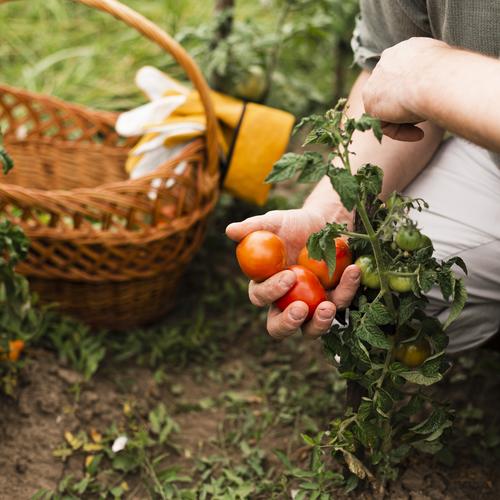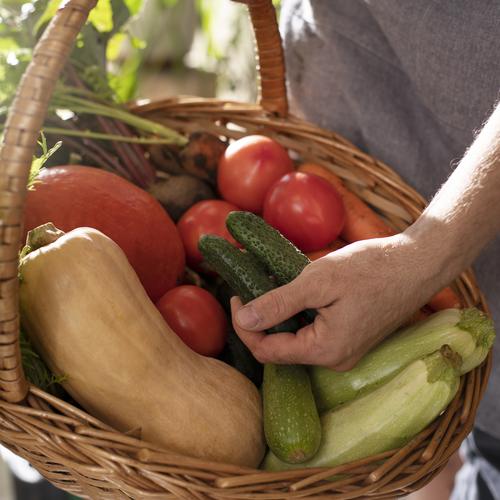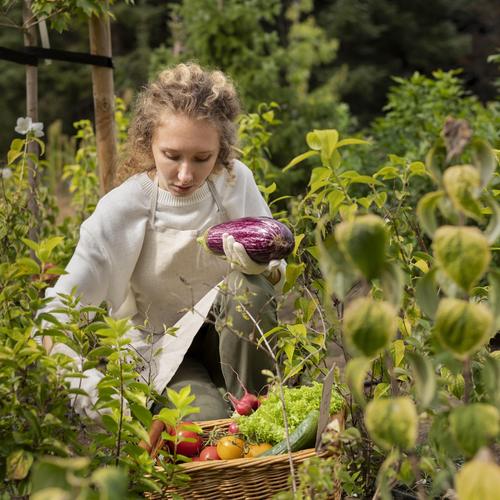Grow Your Own Food Forest
Grow Your Own Food Forest
Creating a food forest involves designing a diverse, multi-layered ecosystem that mimics the structure and function of a natural forest while focusing on producing food. We wanted to share the benefits of cultivating a food forest in your outdoor space and how to achieve it.

What is a Food Forest?
A food forest, also known as a forest garden or edible forest garden, is a designed ecosystem that mimics the structure and functions of a natural forest while focusing on producing food. It incorporates a diverse array of plants, including trees, shrubs, herbs, vines, and ground covers, arranged in multiple layers to maximize productivity and sustainability. The concept of a food forest draws inspiration from permaculture principles, which emphasize sustainable agriculture, biodiversity, and ecological resilience. They can be adapted to a wide range of climates and landscapes, making them a versatile and sustainable option for home gardeners, farmers, and community groups interested in growing their own food in harmony with nature.
Key features of a food forest include:
Layered Structure
Food forests are organized into distinct layers, including a canopy layer (tall fruit and nut trees), understory layer (smaller fruit and nut trees, bushes), shrub layer (berry bushes, culinary herbs), herbaceous layer (vegetables, ground covers), and sometimes a vine layer (climbing plants like grapes or kiwi).
Diverse Plant Selection
Food forests incorporate a wide variety of edible plants, including perennial crops that require minimal maintenance once established. By diversifying plant species, food forests can increase resilience to pests, diseases, and environmental stressors.
Perennial Focus
Unlike traditional annual vegetable gardens, which require replanting each year, food forests emphasize perennial plants that continue to produce food year after year with minimal input. This approach promotes soil health and reduces the need for soil disturbance.
Natural Patterns and Processes
Food forests are designed to mimic the structure and dynamics of natural ecosystems, utilizing principles such as succession, nutrient cycling, and companion planting. By working with natural patterns and processes, food forests can be more resilient and sustainable over the long term.
Ecosystem Services
In addition to producing food, food forests provide a range of ecosystem services, including habitat for wildlife, carbon sequestration, soil erosion control, and water infiltration. They can also enhance biodiversity and support pollinators and beneficial insects.

How to Create Your Food Forest?
Site Selection
Choose a suitable location for your food forest. Look for a spot with ample sunlight, good drainage, and access to water.
Design and Planning
- Determine the size and shape of your food forest.
- Research the native plants and trees that grow well in your climate and soil type.
- Plan the layout of your food forest, considering factors like sunlight requirements, water needs, and the growth habits of different species.
- Decide on the layers of your food forest, including canopy trees, understory trees, shrubs, herbaceous plants, ground covers, and climbers.
Soil Preparation
- Test your soil to assess its pH and nutrient levels.
- Amend the soil as needed by adding organic matter such as compost, mulch, or aged manure to improve fertility and structure.
Plant Selection
- Choose a variety of food-producing plants that are well-suited to your climate and soil conditions.
- Select plants with different harvest times to ensure a continuous supply of food throughout the year.
- Include nitrogen-fixing plants such as legumes to improve soil fertility.
Planting
- Plant your food forest following the design you created, considering the spacing requirements of each species.
- Water newly planted trees and plants regularly, especially during the establishment phase.
Mulching and Mulch Maintenance
- Apply a thick layer of mulch around your plants to suppress weeds, retain moisture, and add organic matter to the soil.
- Replenish mulch as needed to maintain a consistent depth.
Maintenance
- Regularly prune trees and shrubs to shape them and encourage healthy growth.
- Control pests and diseases using organic methods such as beneficial insects, companion planting, and natural sprays.
- Monitor water needs and irrigate as necessary, especially during dry periods.
- Continuously add organic matter to the soil to improve fertility and soil structure.
Succession Planting
- Plan for succession planting to ensure a continuous supply of food throughout the year.
- Replace spent crops with new plantings to maximize productivity and diversity.
Observation and Adaptation
- Observe how your food forest evolves over time and make adjustments as needed.
- Pay attention to how different plants interact with each other and with the environment.
Enjoy and Share
- Harvest the abundance from your food forest and enjoy fresh, homegrown produce.
- Share your knowledge and surplus harvest with friends, family, and neighbours to build a sense of community around your food forest.
- Remember that creating a food forest is a long-term endeavour that requires patience, observation, and ongoing care.
- With time and effort, you can create a resilient and productive ecosystem that provides food while supporting biodiversity and ecological health.

Pros & Cons of Having a Food Forest
Creating an edible garden, whether it's a traditional garden or a food forest, has several advantages and some potential drawbacks. Here's an overview of the pros and cons:
Pros:
Fresh and Nutritious Produce: You have access to fresh, homegrown fruits, vegetables, herbs, and nuts, which are often more nutritious and flavorful than store-bought produce.
Cost Savings: Growing your own food can help save money on grocery bills, especially if you produce a significant portion of your family's fruits and vegetables.
Environmental Benefits: Edible gardens reduce the carbon footprint associated with transporting food from farm to table. They also promote biodiversity and support local ecosystems when managed sustainably.
Physical Activity and Stress Relief: Gardening provides exercise and a connection with nature, which can improve physical health and mental well-being. It can also be a therapeutic activity, reducing stress and promoting relaxation.
Education and Skill-Building: Maintaining an edible garden teaches valuable skills such as plant care, soil management, and pest control. It's also an opportunity for children and adults alike to learn about where food comes from and the importance of sustainable agriculture.
Food Security: Having your own source of fresh produce can increase food security, especially during times of economic uncertainty or disruptions in the food supply chain.
Cons:
Time and Effort: Maintaining an edible garden requires regular attention, including watering, weeding, fertilizing, and pest control. Depending on the size of the garden and the number of plants, this can be time-consuming.
Seasonal Limitations: In some climates, edible gardening is limited to specific seasons, and certain crops may not thrive year-round. This can reduce the variety and quantity of produce available.
Pests and Diseases: Edible plants are susceptible to pests and diseases, which can damage or destroy crops if not properly managed. Organic pest control methods may require more effort and may not always be as effective as chemical pesticides.
Space Constraints: Not everyone has access to enough land or suitable outdoor space for an edible garden. Urban dwellers, in particular, may face challenges in finding adequate space for gardening.
Initial Investment: Setting up an edible garden can require an initial investment in tools, seeds or seedlings, soil amendments, and other supplies. While this investment can pay off over time, it may be a barrier for some people.
Learning Curve: Gardening involves a learning curve, and beginners may encounter challenges such as plant diseases, poor soil quality, or incorrect planting techniques. It may take time to develop the necessary knowledge and skills for successful gardening.
Overall, the benefits of an edible garden often outweigh the drawbacks for many people, but it's important to consider both the pros and cons before starting your own garden. With proper planning, care, and commitment, an edible garden can be a rewarding and sustainable way to grow your own food.

